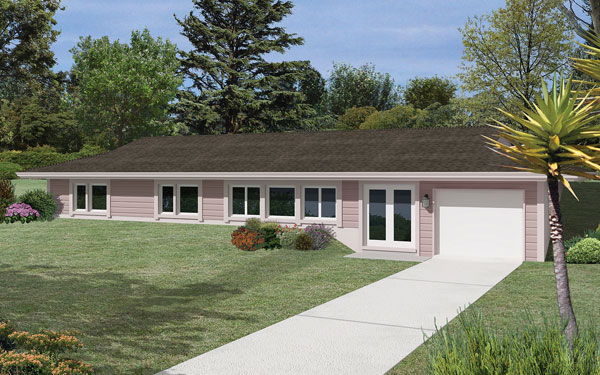Table Of Content

Due to its strength, durability, and fire resistance, concrete is the material of choice most frequently for building structures sheltered by the earth. For walls subjected to lateral or vertical pressure from soil cover, brick or stone masonry reinforced with steel bars can be used. In earth-sheltered structures, wood can be used extensively for internal and structural construction, including flooring, roofs, and exterior walls. A building with earth (soil) against the walls, on the roof, or completely buried underground is called a bermed Earth-shelter home. Earth’s role as thermal mass makes it simpler to keep a constant indoor air temperature, which lowers the expense of heating or cooling systems.
Bermed Earth Sheltered Homes
According to the US Department of Energy, underground structures can be prone to flooding if snowfall is not considered in the design. Soil stability should also be considered, especially when evaluating a sloping site. These slopes may be inherently stable when left alone, but cutting into them can greatly compromise their structural stability. Retaining walls and backfills may have to be constructed to hold up the slope prior to shelter construction. Other notable proponents of earth sheltering active in this era include Mike Oehler, Rob Roy, John Hait, Malcolm Wells, Peter Vetsch, Ken Kern and others. Now when most people think of an earth shelter, they picture a Hobbit House… but they can look like anything you want them to; It all depends on the design.
Earth-Sheltered Home: An Eco-Friendly, Passive Housing Alternative
Another historical example of in-hill earth shelters would be Mesa Verde, in southwest USA. These building are constructed directly onto the ledges and caves on the face of the cliffs. The front wall is built up with local stone and earth to enclose the structure. The floor plan is arranged, so that common areas and bedrooms share this light and heat from the southern exposure.
Underground
The ease with which the building can be surrounded by soil depends on the topography and microclimate of the site. © Copyright 2024 houseplansandmore.com, A division of Design America, Inc. "I woke up and looked out on the beach and the waves were coming up to the house... The whole street was flooded and we had water coming into our garage," said resident Brady Karich. View our earth home construction gallery to take a look at some of our recent projects and work-in-progress. Together with his wife, Tiffany, who serves as Director of Marketing, Cameron is excited to help you plan and build your forever home. Grzibowski remembers when the a housing development near his home led to the clearing of dozens of trees on that hill.
Massive Underground Home In California Virtually Disappears Into the Landscape
This type of layout can also be transposed to a double level house design with both levels completely underground. This plan has the highest energy efficiency of earth sheltered homes because of the compact configuration as well as the structure being submerged deeper in the earth. This provides it with a greater ratio of earth cover to an exposed wall than a one-story shelter would. The type of structure, depth below grade, and soil type should all be considered when choosing construction materials for a bermed earth-sheltered home.

Exterior
Our House: Life 'underground' in a berm home - Worcester Telegram
Our House: Life 'underground' in a berm home.
Posted: Fri, 29 Aug 2014 07:00:00 GMT [source]
Earth-sheltered homes are popular among eco-friendly homeowners, but they should be popular among everyone. They are storm-proof, earthquake and fire-resistant, plus extremely energy-efficient, soundproof, less susceptible than typical houses to extreme temperatures, and require less maintenance. Natural drainage away from the building is the best way to avoid water pressure against underground walls, but installed drainage systems can be used to draw water away from the structure.
“Anyone can build one of these, it’s just like building a walkout basement,” Dennie says. Finally, in some areas, like North Carolina, radon is a safety issue requiring testing. For we modern Southern folks, going one summer without the comforts of air conditioning is unthinkable.
Energy saving and practical, earth bermed homes are a great choice.
Folks on the street may call them “hobbit houses” in reference to J.R.R. Tolkien’s work, but earth-sheltered homes have been around for far longer than 1937 when the novel was published. Alternative housing is expected to continue increasing in popularity as the green building trend surges and energy prices go up, which means you may find an enthusiastic buyer willing to pay top dollar. But, since there are no guarantees in real estate, it is something to keep in mind. So be sure to talk to your contractor about installing the proper EVR valves, fresh air and/or heat exchangers. To insulate an earth-sheltered home, Dennie generally recommends putting an r-50 or r-58 insulation in the ceiling and r-20 in the walls and flooring. Here you will find a listing of all of the plans that employ earth-berms.
Hobbit Home For Sale In Hastings, Minnesota - B105 Country
Hobbit Home For Sale In Hastings, Minnesota.
Posted: Mon, 17 Jul 2023 07:00:00 GMT [source]
Concrete is the most common choice for constructing earth-sheltered buildings, because it strong, durable, and fire resistant. Concrete masonry units (also called concrete blocks) reinforced with steel bars placed in the core of the masonry can also be used, and generally cost less than cast-in-place concrete. A bermed house may be built above grade or partially below grade, with earth covering one or more walls.
While a wooden framed roof of adequate size can support a lighter living roof, only concrete will be strong enough to support a thick layer of earth. Oftentimes, three of the four sides of the home are covered by earth. In the colder climes of the northern hemisphere, the south-facing side of the house is not bermed and a large amount of glazing (windows) is used to permit the entrance of light and heat from the sun in the southern sky. In hot climates, this orientation can be reversed so that the south side is bermed and the cooler north side is left as the exposed side of the home. Despite their partially underground location, earth bermed homes can be designed to bring in as much light and fresh air as traditional houses. The idea behind passive annual heat storage is to use direct gain passive solar heating and a thermal battery effect that lasts several months to maintain a consistent temperature within an earth shelter all year round.
These methods rely on the U factor or thermal heat storage capacity of the earth itself below the frost layer. These designs are the exception however and risk frost heave damage in colder climates. The theory behind no insulation designs relies on using the thermal mass of the earth to store heat, rather than relying on a heavy masonry or cement inner structures that exist in a typical passive solar house. This is the exception to the rule and cold temperatures may extend down into the earth above the frost line making insulation necessary for higher efficiencies. Home Plan # D-0206Berm homes were originally designed as a solution to the energy crisis in the 1970’s. This type of house plan is one of the most energy efficient homes you can build.
So now that we have gone through the technical details of building an earth-sheltered home, let’s look at some examples of these homes that people have built around the world. The walls that have earth piled up against them will also have to be specifically designed to handle the forces of the dirt on the wall. An average stick-framed wall won’t hold up to the pressures exerted. These walls will need to be designed like a retaining wall because that is exactly what they are. Some of these walls will include buttresses, and others may be circular as a circle is much stronger than a long straight wall. An earth-sheltered home is one that uses a large quantity of earth (dirt, soil, subsoil, etc.) as a protective barrier on a good portion of the exterior of the house.
Unlike the conventional building, earth shelters require the insulation on the exterior of the building rather than inside the wall. One reason for this is that it provides protection for the waterproof membrane against freeze damage, another is that the earth shelter is able to better retain its desired temperature. There are two types of insulation used in earth shelter construction. Two to three inches glued to the outside of the waterproofing is generally sufficient. The second type of insulation is a spray on foam (e.g. polyurethane solid foam insulation).

No comments:
Post a Comment